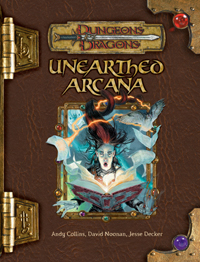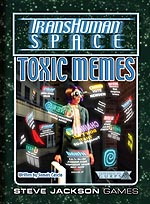By Jonathan Woodward
Jun 6, 2004
Welcome to another occasionally-exciting review column here at Exploding Dice.
Open Arcana
 |
Unearthed Arcana (Wizards of the Coast, for Dungeons & Dragons, 224 pages, hardcover, full-color, $34.95) is a certain sign that innovation isn't dead among the Wizards. It is rampagingly full of rules options for D&D, including (to name just ten) variant races, variant classes, spelltouched feats, craft points, armor as damage reduction, the use of hex grids, metamagic components, item familiars, reputation, and sanity. Some of them come from other WotC d20 games (notably, the Star Wars RPG and d20 Modern), others are fairly obvious attempts to incorporate ideas from other RPGs. (Y'know, games that have moved beyond hit points that increase as the character advances.)
The big news here is in teeny little print on the title page: "Except for [a few minor exceptions], the contents of this . . . game product are Open Game Content, as defined in [the OGL]." Which is to say, other game publishers are free to take darn near anything they like out of this book and use it in theirs. (Within the terms of the Open Gaming License, which are not overly onerous.) This is a gutsy move on a par with inventing the d20 and Open Gaming licenses in the first place, and I gotta say, "Bravo." WotC may not be a perfect corporate citizen, but let no one say they stifle innovation.
As for content, there are far too many cool things for me to mention them all, so I'll just pick half-a-dozen or so. To start, racial paragon classes let you advance in the class of "being a member of your race." For example, a dwarf who takes levels in Dwarf Paragon gains improvements to her stonecunning, her darkvision, and her Con, among others. This is an obvious extension of the Monster Classes from Savage Species (where you take levels in "being a medusa," for example), and a cool way to empower a player who thinks of her character more in terms of her race than her class. The paragons are followed by over 30 pages of variations on the base classes, and how to advance in them. One possible change offered is making the ranger, paladin, and bard into prestige classes. Each of them conceptually resembles the culmination of training in another profession, and this changes the game mechanics to match. The prestige classes are, natch, more powerful than the originals, and thus you're encouraged not to allow both types in one campaign, but for GMs who have always felt that a 1st-level paladin seemed kinda contradictory, here's your fix.
Spelltouched feats are a cute way of getting minor magical abilities, so long as there's an in-game explanation. For example, if there's a PC in your game who's acquired the nickname "lightning rod" because of his tendency to get zapped by bolts of electricity, he qualifies to take the Conductivity spelltouched feat, which allows him to redirect some electrical damage whenever he gets hit again. We also get a vast array of damage variants (making the game more or less realistic, as you see fit), and a defense bouns option. This last reduces the game's dependence on PCs picking up magical armor as they advance. Every class gets a bonus to AC that goes up with level, but does not stack with armor. This can promote adventures that look more like swashbuckling and less like magical tanks.
And there's more, more, more. Item familiars let you form a permanent bond with a magic item, so that it gains abilities as you do. Honor provides a set of mechanics for charting a character's adherence to a code, and reaping the benefits of good behavior. And, really, I've only mentioned a third of the options in this book.
I should, at this point, provide a caveat. D&D is class-and-level based, and this book doesn't change that. This means that it occasionally needs to jump through hoops to allow characters to become a little more powerful, or slightly different. E.g., to acquire one of the bloodlines (being a distant descendant of a dragon, for example), you need to "burn" a few character levels over the course of your PC's progression. In other systems, this would just be a matter of spending character points, or what-have-you. In some ways, this book highlights the weaknesses of the underlying system. That said, while hoop-jumping is going on, it's being done very gracefully and with attention to detail.
Oh, and lest I forget, production values are predictably excellent, the editing is great, and it's got a cool cover. Strongly recommended to D&D GMs and players. It's probably much less useful to anyone else -- it is mostly rules variants -- but it's still a potential source of inspiration.
Memes and Dreams
 |
This is going to be a double review of Transhuman Space: Broken Dreams and Transhuman Space: Toxic Memes (Steve Jackson Games, powered by GURPS, 144 pages each, softcover, black-&-white, $24.95 and $26.95 respectively), the two most recent sourcebooks for SJGames' near future wild-n-wooly Transhuman Space setting. Both are by Jamais Cascio, who is an accomplished futurist writer. These are his first RPG books.
Of the two, I found Memes to be the better book. (Maybe that's why it costs $2 more.) It is a big book of ideas, from cults like the vaugely Scientological Ecoherence movement, to cultural movements like The New Virginity. Heck, just listing off a few of the section headings can give SF GMs ideas: Acolytes of the Dark, Singularitanism, Cryptosurvivalism, Human Species Retirement, Geonomic Invasion, Changeling Infomorphs, Patterns in the Static, Kabbalistic Space Tourism, Society for Applied Teratology, Artifactists, Clonibalism, Timesicles, Animal Reparations, Delugism. Most of the memes explicated in this book could form the basis of a campaign or at least an adventure, all by themselves, and the few that couldn't still make great background detail. Plus, lengthy descriptions of how memes work in the setting, and a rules system for those PCs who desire to manipulate memes themselves. If you wanna make your players go, "Woah, the future is weird," you gotta get this book.
 |
Dreams, by contrast, is a geography book, devoted to that part of Earth which is home to the have-nots of the TS setting. It covers two major international power blocs (the Islamic Caliphate, and the Transpacific Socialist Alliance), three cities suitable as foci for three very different campaigns (bleeding-edge Nairobi, Orwellian Alma-Ata, and moderately-ruined L.A.), and, most importantly, what it's like living a whole technological revolution behind the Fifth Wave world. Cascio goes into the assorted trickle-down effects in great detail, and it's all good stuff. Plus, new character types, old technology, and more. If I rate this book below Memes, it's only because it's a bit dry. That's hard to avoid when you've got to deal with economics, sociology, history, and geography, and Cascio comes close, but I still found my attention wandering a bit.
The editing in both is pretty darn good, with no more than one error every half-dozen pages. The art varies from excellent to doesn't-match-the-text (Dreams, p. 114) to recycled (Dreams, p. 139, appeared in Fifth Wave) to suspiciously familiar (that same pic looks a lot like the battleship from Martian Successor Nadesico). In summation, Memes is highly recommended to anyone doing a near-future SF game, and absolutely required reading for Transhuman Space gamers. Dreams is strongly recommended to TS gamers, and mildly recommended to cyberpunk GMs.
Dead Boys Don't Cry
Dead Inside (Atomic Sock Monkey Press, 128 pages (depending on whether you count the cover), PDF, black-&-white, $13.00) is Chad Underkoffler's much-lauded auteurist RPG about the moment people go, "Oh, crap, where's my soul?" The premise: You're a citizen of modern-day America who, for one reason or another, has no soul. (Insert lame joke about the President here.) On the plus side, you get some minor powers. The downside is that you are left with a burning ache and a lessened ability to relate to others. (Insert lame joke about Asperger's and heartburn here.) But, by doing good deeds, you can replace or recover your soul, and keep the powers.
The cosmology is beautifully put together, with numerous bastions of urban (and traditional) fantasy (e.g., zombies, mages) given rationales that neatly dovetail into the souls-and-lack-thereof premise. The setting is Earth as we know it and the Spirit World. The latter has enough unique quirks to be interesting and fulfilling, but it's also generic enough to evoke thoughts of, "Yeah, I've seen this before." That's not necessarily bad; if you want to do Sandman: The RPG, you've got the tools here, but it does thin out Dead Inside's unique identity.
The rules are simple. Starting soulless PCs must pick a selection of Qualities which describe them, and then rate them from Master (+6) to Poor (-2). Each must have 8 points of positive Qualities and one Poor Quality. (Though, oddly, the text doesn't come right out and say that, instead saying, "Pick four good, or one expert and two good, or two expert, or..." Possibly this was a deliberate attempt to avoid making the players add short columns of small numbers.) Rolls are made on 2d6, modified by applicable Qualities and situational modifiers (like, if you're soulless, you're at -2 to deal with people socially). Your Qualities also serve as hit points; damage of any sort (a punch, getting snubbed at a party) lowers your Qualities until you can no longer participate in the conflict. It's not complicated, though the jargon can take some getting used to. Looking through the rules, I saw places where I felt they could use tightening, but then, I'm obsessive that way.
 |
Dead Inside was conceived as a game that rewarded good behavior directly. You start out in debt to the house, and the only way to break even, let alone acquire all the cool shiny powers that mages get, is to Be Excellent To Each Other. It's hard to imagine something more opposite to traditional D&D. This also makes it very character-driven, and very much in need of cool setting bits that support the standard play style. Underkoffler has one expansion in the pipe already, so I suspect we're in good hands there.
The PDF is well laid-out. The art is scarce and, while evocative, not the best I've ever seen. Typos are few and mostly of the extra word/missing word variety. But, for half the price of a typical 128-page RPG book, I have few complaints. So, strongly recommended for those looking for a unique urban fantasy RPG, and also to those who have grown tired of doing the dungeon stomp. Not really recommended to people who are perfectly happy bashing dragons on the head, though some of the Spirit World monsters might make nice CR 2 encounters.
Next Month: Hearts, Poison, and more.
Useful Links:
Want me to review your game? I'm delighted to accept review copies care of Blue Blood.
